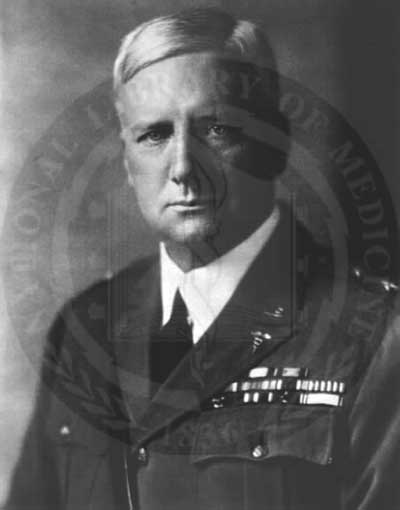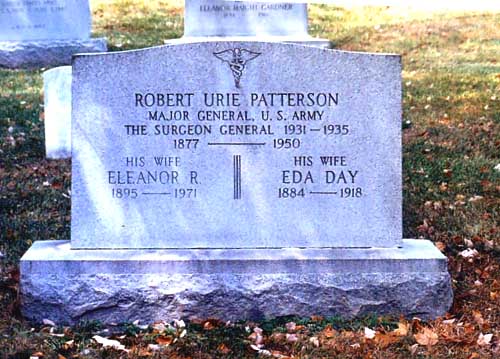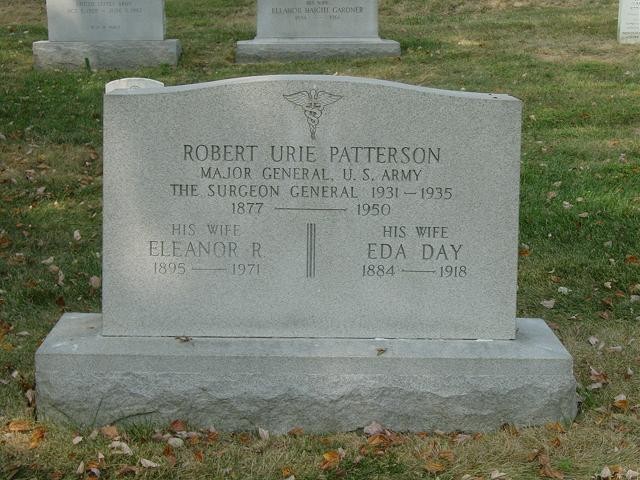Courtesy of the United States Army
ROBERT URIE PATTERSON (June 16, 1877-December 6, 1950) , The Surgeon General, June 1, 1931 -May 31, 1935, was born on June 16, 1877, at Montreal, Canada, the second of seven sons of an American family residing in Canada. His father, William James Ballantyne Patterson, was the son of Scotch parents, William Jeffrey and Janet Galbraith Urie Patterson, who came to this country from Glasgow, near the middle of the last century. His mother was Eleanor Haight Lay, daughter of Robert Lay, direct descendant of the first Robert Lay who landed at Saybrook, Connecticut, with Lords Say and Seale, about 1635. Young Robert attended Berthier Grammar School and Bishop’s College School in Quebec, Canada, and later when the family moved to San Antonio, Texas, attended San Antonio Academy. Returning to Montreal he entered the Montreal Collegiate Institute and later McGill University where he was graduated in 1898 with the degrees of M. D. and C. M.
After a year of internship (1898-1899) in the Montreal General Hospital and another year (1899-1900) as resident accoucheur at the Montreal Maternity Hospital he went to Belt, Montana, for private practice. The next year, however, he took the examination for the army medical service and was commissioned an assistant surgeon with the rank of first lieutenant on June 29, 1901, from the state of Maryland. His first station was Fort McHenry in Baltimore, where he remained until the opening of the Army Medical School in Washington in November. He completed the course the following April as an honor graduate and was immediately ordered to duty in the Philippine Islands. Arriving in Manila on May 12, 1902, he was sent to duty in Laguna province, serving several sub-stations from his post at Binan. This service was in the midst of an epidemic of cholera which was especially severe around the Laguna de Bay. After some months of this duty be was transferred to the Convalescent Hospital on Corregidor Island where be served for three months. In December he was transferred to the Department of Mindanao, reporting at Zamboanga from whence he was ordered to duty at Camp Vicars on Lake Lanao.
Arriving at Camp Vicars on January 8, 1903, he saw a year of duty marked by desperate fighting with insurgent Moros in the center of Mindanao and on the island of Jolo. In these engagements he displayed not only professional skill under trying circumstances, but showed conspicuous gallantry under fire. Many years later he received from the War Department two Silver Star citations for gallantry in action in caring for the wounded throughout the hand to hand fighting incident to the attack on Fort Bacolod, Mindanao, April 8, 1903, and for gallantry in the action against hostile Moros at Fort Pitacus on Lake Lanao, May 4, 1903.
The year of 1904 was spent largely at the post of Zamboanga on sanitary service with the municipality and in the post hospital. In December 1904 he was transferred, sick, to the First Reserve Hospital in Manila, from whence he went to duty in charge of the Quartermaster Dispensary, with additional duty as sanitary inspector at the Division headquarters. Returning to the United States in June 1906 he was assigned to the Presidio of San Francisco and placed on duty with Company “B” Hospital Corps under Captain Albert E. Truby, with additional duty as sanitary inspector. With the company he took an active part in the work incident to the earthquake and fire of April 18, 1906. When, in 1906, the Cuban Pacification was undertaken he went with Company “B” Hospital Corps from the Presidio of San Francisco to Newport News and embarked in October of that year for Havana where they took station at Camp Columbia. The company was here reorganized and named Field Hospital No. 10. He returned to the United States in April 1909 and was assigned to command of Company “C” Hospital Corps then at Walter Reed Hospital in Washington but soon transferred to Fort Niagara, New York. In April 1910 he went to Fort Banks, Mass., where he served until June 1913. This duty was interrupted by a term of service with the Maneuver Division assembled at Fort Sam Houston from March to July 1911, where be served first as commanding officer of a field hospital and then became director of ambulance companies of the Maneuver Division. In 1912 he took a course in medical field service at Fort Leavenworth. From Fort Banks he was ordered to Washington in June 1913 for duty with the headquarters of the American Red Cross in charge of its first-aid department. In 1916 he was director of the Bureau of Medical Service, American Red Cross.
In connection with his Red Cross duties he went to England, France, and Holland, sailing from New York on the Red Cross ship, September 13, 1914, in charge of American Red Cross surgeons and nurses on their way to duty with the different belligerent powers in the care of their sick and wounded, and returning on October 24. He was still on duty with the Red Cross when the United States entered the World War. On May 11, 1917, he sailed again for England, this time in command of U. S. Army Base Hospital 5 (the Harvard Unit), and on May 30 arrived with it in France. While located at Dannes-Camiers with the British forces the hospital was bombed by a German plane on September 4, 1917, the first unit of the United States Army to suffer casualties after the country entered the World War. Lieutenant Fitzsimons and Privates Tugo, Rubino, and Woods were killed, while three officers and five privates were seriously wounded. In February 1918 Colonel Patterson was appointed a member of the American Military Mission to Italy. He served as a general medical inspector in May and June 1918 and was on duty with the Second Division in June 1918 during the active operations leading up to Chateau Thierry, and with the “Paris Group” until July 2, 1918. In the following month he returned to the United States for duty in the office of The Surgeon General.
For his service in the war he received a citation [Distinguished Service Medal] and the War Medal from the British War Office. The Italian government gave him the Fatiche di Guerra, the Medaglia del’ Unita, and made him an Officer of the Crown of Italy. He was also made an Officer of the Czechoslovak Order of the White Lion and received the Serbian Red Cross decoration. From his own government he received the Distinguished Service Medal.
Through the years he bad been advancing in the military scale . From a captaincy, reached on June 29, 1906, he was promoted to major on January 1, 1910, to lieutenant colonel on May 15, 1917, and to the temporary grade of colonel on December 17, 1917, which he held until June 30, 1920. Late in 1918 Colonel Patterson was assigned as an instructor in the Army War College and later was transferred to the War Department General Staff in the Operations and War Plans divisions respectively. He graduated from the War College in June 1921 and returned to The Surgeon General’s office in the training division. He was placed upon the General Staff eligible list. In August 1921 he was detailed as Medical Director, U. S. Veterans’ Bureau, which post he filled until February 1923 when he was placed in charge of the medical section of the Washington General Intermediate Depot. After a few months of this duty he was brought again into the office of The Surgeon General as executive officer, where he served for two years. He was then assigned to the command of the Army and Navy General Hospital at Hot Springs, Arkansas. He spent five busy years (1925-1930) at this station, reaching the grade of colonel on June 29, 1927. In August 1930 he went to the Hawaiian Department as department surgeon at Honolulu.
As the months of General Ireland’s term of office were drawing to a close in 1931 there was the usual number of active candidates for the expected vacancy. Rumors and speculation were rife and were only partially stilled when orders were issued for Colonel Patterson to return to the United States. His return was followed by his appointment as The Surgeon General with the grade of major general from June 1, 1931.
General Patterson came to the office at a very inauspicious time. It was a period of deep economic depression throughout the country and a time of economy and retrenchment in government business. Suspension of the Army School of Nursing was approved by the Secretary of War August 12, 1931, for reasons of economy, and the school was discontinued as of January 31, 1933. Indications were that effort was necessary to save past accomplishments from being undone rather than to undertake new ones. However, despite these handicaps, there were material achievements to be recorded for the years of his term. At the Army Medical Center the center and north wing of the school building were constructed, new buildings obtained for the utilities of the post and two wings added to Delano Hall, the nurses’ home. The entire rebuilding of the Army and Navy General Hospital at Hot Springs, Arkansas, was completed in October 1933. Among other new hospital construction, fine new buildings were built at Fort Jay, New York, and Fort Bragg, North Carolina. The inauguration of the Civilian Conservation Corps in 1933 placed a new load of responsibility upon the medical service and brought a greatly increased burden upon general and post hospitals. This was not without its advantages as it provided for increases in hospital personnel and made funds available for the thorough equipment of station hospitals. There was begun at this time a plan to make the equipment of the station hospitals as modern as that of the general hospitals and very material progress was made upon this plan. In 1934 the third tropical disease board which had been established in Manila in the spring of 1922, was removed to Ancon in the Panama Canal Zone, where, by July it was established in the Board of Health Laboratory, Gorgas Hospital.
Throughout his term of office General Patterson maintained close touch with the officer personnel and increased an already great popularity. Of fine figure and handsome face, of jovial manner and good address, with a gift of ready language, he was called upon for much public speaking during his term as The Surgeon General.
Upon completion of his four years of office General Patterson was relieved as Surgeon General May 31, 1935. Though six years short of the mandatory retirement age he chose to retire, and in doing so accepted the post of dean of the University of Oklahoma Medical School and that of superintendent of its two teaching hospitals at Oklahoma City. Closely following the termination of his duty as The Surgeon General he was sent to Brussels, Belgium, as a representative of the United States at the Eighth International Congress of Military Medicine and Pharmacy. His retirement with the rank of major general was effective November 30, 1935.
General Patterson is a fellow of the American College of Surgeons and of the American College of Physicians, a member of the American Medical Association, of the Association of Military Surgeons of the United States, of the Military Order of the World War, and of the Military Order of the Carabao. McGill University in 1932 awarded him the honorary degree of LL.D.
Of his six brothers, the eldest entered the army in 1901, became one of its first aviators and was retired as a colonel in The Adjutant General’s Department. Three other brothers were emergency officers during the World War, one each in the infantry, artillery, and air corps. Physical disabilities precluded the two remaining brothers from war service.
General Patterson was married on March 28, 1905, at Zamboanga, P. I., to Eda Beryl Lorraine Day of Dayton, Washington, who died in April 1918. On August 14, 1920, he married Eleanor Reeve of Brandywine, Maryland. There are four children of the two marriages, General and Mrs. Patterson have been residents of Oklahoma City since his retirement from the service in 1935.
Editor’s Note:
Major General Patterson remained Dean of the University of Oklahoma Medical School until 1942 when he assumed the post of Dean of the School of Medicine of the University of Maryland in Baltimore. He resigned his position several years later due to ill health. In 1949 he was made a life member of the Association of Military Surgeons of the United States. He died from pneumonia at Walter Reed Army Hospital on December 6, 1950. On December 8, 1950 he was buried in Arlington National Cemetery. He was survived by his wife and four children.
PATTERSON, ROBERT U
MAJ GEN USA
VETERAN SERVICE DATES: Unknown
DATE OF BIRTH: 06/16/1877
DATE OF DEATH: 12/06/1950
DATE OF INTERMENT: 12/08/1950
BURIED AT: SECTION 3 SITE 4200
ARLINGTON NATIONAL CEMETERY
PATTERSON, EDA DAY W/O ROBT U
DATE OF DEATH: 04/04/1918
BURIED AT: SECTION S-N SITE 4200
ARLINGTON NATIONAL CEMETERY
WIFE OF RU PATTERSON, COL MED CORPS USA
PATTERSON, ANN PATRICIA D/O ROBT U
BURIED AT: SECTION S. CT SITE 4200
ARLINGTON NATIONAL CEMETERY
DAUGHTER OF RU PATTERSON, COL, USA
Michael Robert Patterson was born in Arlington and is the son of a former officer of the US Army. So it was no wonder that sooner or later his interests drew him to American history and especially to American military history. Many of his articles can be found on renowned portals like the New York Times, Washingtonpost or Wikipedia.
Reviewed by: Michael Howard



